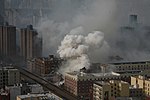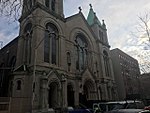Clinton Houses
Governor DeWitt Clinton Houses, also known as DeWitt Clinton Houses or Clinton Houses, is a public housing development built and maintained by the New York City Housing Authority (NYCHA) in the Spanish Harlem neighborhood of Manhattan. Clinton Houses is composed of six buildings, resting on a non-continuous campus with an area of 5.6 acres (23,000 m2). Five of those (I-V) are 18 stories high, and another (VI) is nine stories high. The six buildings have a total of 749 apartments, which house 1,823 people. Clinton Houses occupies the two blocks that are bordered by East 110th Street to the north, Lexington Avenue to the east, Park Avenue to the west, and East 108th Street to the south. It also occupies the western half of the two blocks that are bordered by East 106th Street to the north, Lexington Avenue to the east, Park Avenue to the west, and East 104th Street to the south, with the exception of a small part along East 106th Street.
Excerpt from the Wikipedia article Clinton Houses (License: CC BY-SA 3.0, Authors).Clinton Houses
Lexington Avenue, New York Manhattan
Geographical coordinates (GPS) Address Nearby Places Show on map
Geographical coordinates (GPS)
| Latitude | Longitude |
|---|---|
| N 40.7973 ° | E -73.94258 ° |
Address
James Weldon Johnson Playground
Lexington Avenue
10037 New York, Manhattan
New York, United States
Open on Google Maps







